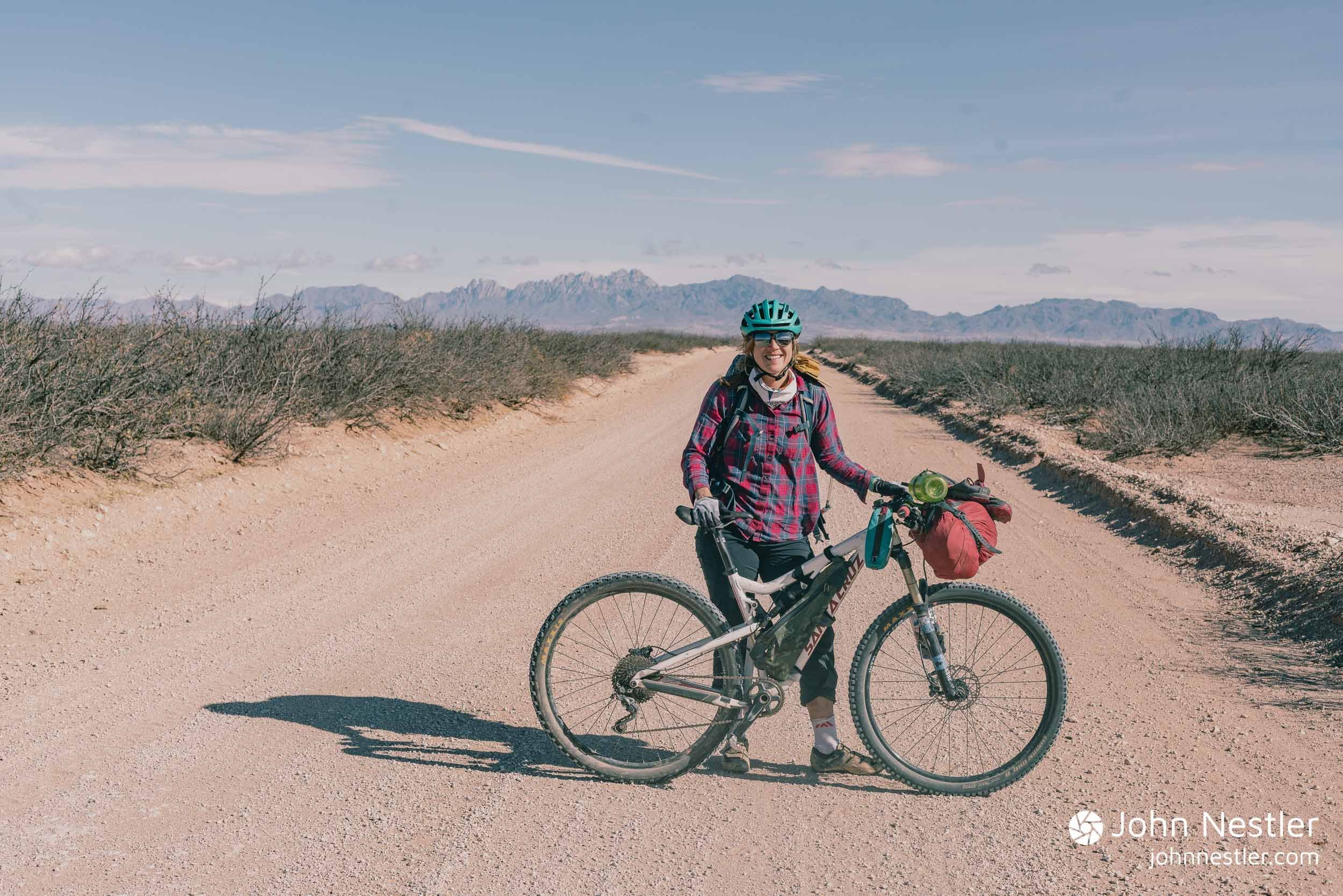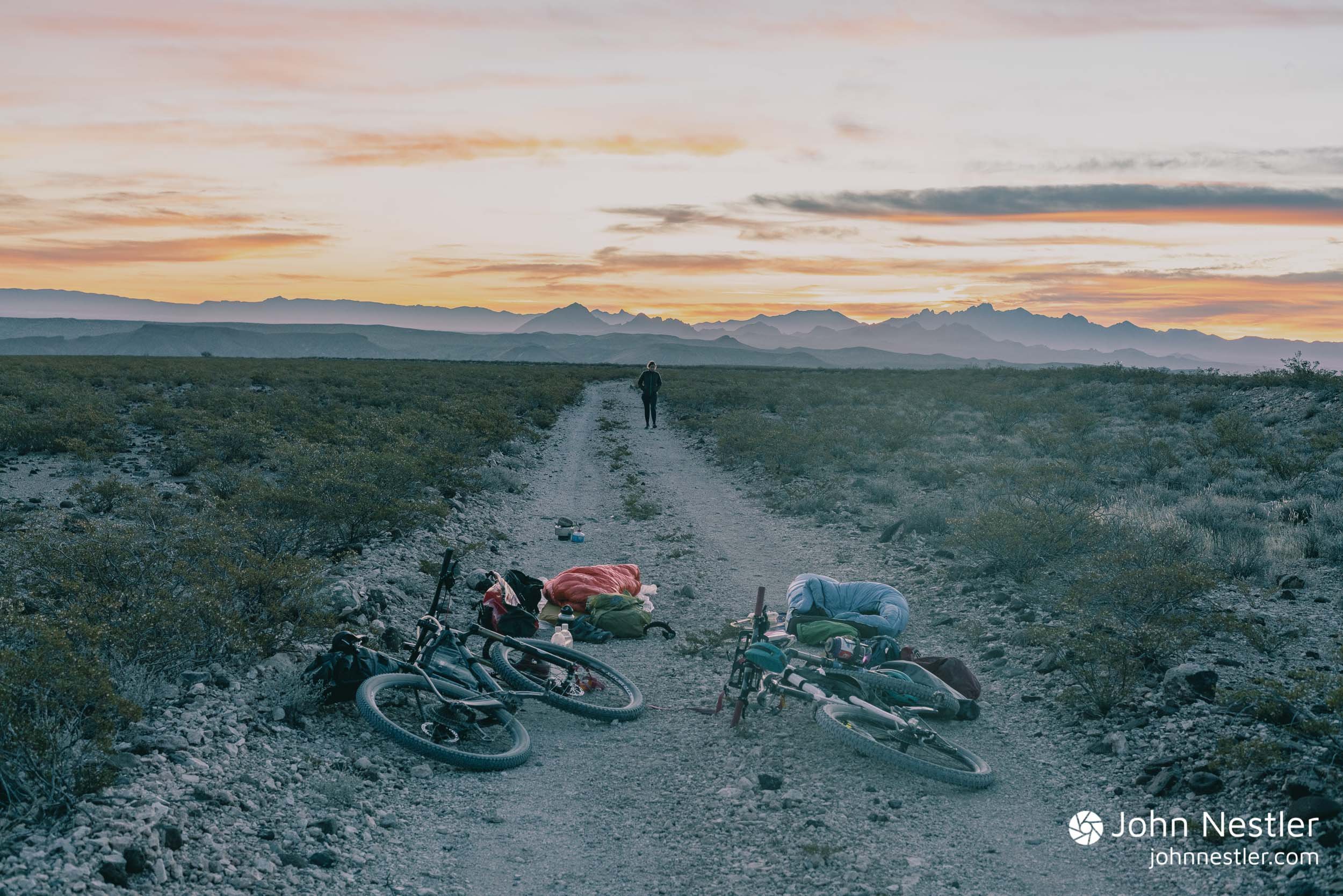Trip Report: Bikepacking the Monumental Loop in Las Cruces, New Mexico
Dates: December 21st - 25th, 2021 (5 days, 4 nights)
Total Miles: ~ 240 miles
Elevation Gain: ~ 8,000 ft
Route Info: Monumental Loop on Bikepacking.com
Update: Andrew Strempke put down a blazing fast FKT of just over 24 hours on this loop in March 2022!
Backstory
With a hut trip planned in Colorado for the holidays Amelia and I set about brainstorming another adventure to tack onto what seems to be our annual road trip out West. Last winter we did the Lower Canyons of the Rio Grande, and would have loved to return, but there's only been a trickle of water coming down that section lately. Bikepacking came to the top of the list for warm(er) weather activities, and we kept hearing about the Monumental Loop in Las Cruces from two local riders who had completed it earlier in the year. It seemed like the perfect activity to welcome the winter solstice.
We had both done the Gila River Ramble a few years ago, and were excited to experience a bit of the Chihuhuan Desert before heading up to the snowy mountains of Colorado. Personally I'd spent time exploring Northern New Mexico in college - areas like the Chama River, Valles Caldera, and Santa Fe, but never got to explore the landscape around Las Cruces.
Amelia did a great job gathering beta, and I took a bit of a backseat in the planning. The route looked like a nice mix of dirt road, some pavement, and a bit of singletrack with a moderate amount of climbing. Unsurprisingly, the route was quite a bit more strenuous than I anticipated. Part of that was Amelia being in really good shape, but the wind was also a force to be reckoned with. More on that later though.
Origins of the Route
The Monumental Loop is the brainchild of Matt Mason and Pablo Lopez, and it has helped put Las Cruces on the map for bikepacking. The route weaves through the Organ Mountain-Desert Peaks National Monument which was granted monument status by President Obama in 2014. Pieces of history on this land include an Apollo training site at Kilbourne Hole, sites used by Billy the Kid and Geronimo, and parts of the Butterfield Stagecoach Trail on its way to San Francisco.
A subtle signal that you’re still on track.
Logistics
Outdoor Adventures bike shop, where Pablo Lopez is the manager, is a great source of information about the route as well as any last minute gear needs. I was told that they recommended cyclists park their car at the convention center in town, but it's worth checking on this closer to your trip.
Resupplies: We were able to refill water and grab food in Hatch, Vado, and Vinton. The grocery store in Hatch is extensive, and we only grabbed gas station snacks in the other towns. We left half of our food in our car in Las Cruces to resupply with when we started the second loop.
Weather conditions: The southern loop is very exposed and dusty. We rode the northern loop first in the traditional style, but if there is a significant wind event in the forecast I would prioritize doing the southern loop on the calmer days.
Water: All the marked cattle tanks had water of varying qualities when we rode through. It took a bit of creative problem solving to get water from a few but it's doable. The southern loop is very dry so keep your waters topped off. We were able to drink mostly water from town stops, but used some cattle water for cooking.
Bike gear: Bike lights are essential if you want to make miles during the shorter winter months. Tubeless tires are a must - mine are still studded with the thorns sheared off from goatheads.
Day 1 - Las Cruces to County Road E006/Barksdale Road (50 miles)
We took our time rolling out of Las Cruces, adjusted gear, and biked a few miles through town to the link up with the route heading north out of town. We were quickly acquainted with the expansive pecan groves, a staple crop of the region, as we followed irrigation ditches towards the Dona Ana Mountains. The singletrack below the peaks here was surprisingly fun and offered a fast, sometimes loose descent down a powerline trail back to cross under Highway 25. The next section under the Robledo Mountains consisted of a flat multiuse trail paralleling the Rio Grande and then fast road miles on Hwy 185 until turning off towards Cedar Hills.
Enjoying some of the twisting singletrack below the Dona Ana mountains.
Cedar Hills marked the start of the real meat of the day where the climbs flexed their muscle. Most of the elevation gain in the route happens within the first 100 miles, so prepare for this if you do the northern loop first (the standard direction). There were a few impressively steep pitches which put my 1x12 granny gear to work, a few cruisy sections, and couple patches of loose sand to prep us for the rest of the trip. We reached the cattle tank at mile 47 at dusk, topped off water, and rode a few miles in the dark to camp on a dead-end offshoot road.
A stunning sunrise view from our camp near the Barksdale road descent.
Day 2 - County Road E006/Barksdale Road to County Road D010 (47 miles)
We woke up to a beautiful sunrise view and kept our puffies as we enjoyed the downhill cruise towards Hwy 185 which took us into Hatch. Unfortunately Sparky's wasn't open the day we passed through, but we resupplied at the very well stocked Village Market (they have really good fried chicken), and packed a burrito and green chile burger from the Village Café for dinner that night. From our beta we knew that the climb up to Big White Gap was the crux of the trip so we tried not to linger too long in comfy civilization.
The section from Hwy 26 to Big White Gap is…interesting. You turn off the highway at a dairy farm, get some whiffs of cow manure, and then begin a deceivingly difficult 9 mile trek up doubletrack of increasingly poor quality. It starts off as loose sandy and then develops into loose rocks that seem to grow in size. It's mostly all rideable if you're committed but it's slow going. The last few pitches are more hike-a-bike style so I'd pack some shoes for this. It's best to plan to clear this section in the daylight, and don't let your guard down once you crest Big White Gap - the loose boulder rocks make for a squirrely downhill if you choose to ride it.
It looks easy here, but a slight uphill grade and large, loose rocks makes for slow going!
The trail treated us right though. Just as the day started to get long we popped out on paved County Road D012 right below Magdalena Peak. This was a screaming downhill with views towards Las Cruces, and easy miles to get to the roadside Camp 2 near the intersection of D006 and D010. I really came to appreciate the nice mix of strenuous climbs followed by fun downhills on the route…it makes for a really nice way to end the day.
Day 3 - County Road D010 to the Bishop Cap (51 miles)
The return to Las Cruces! The day started off with mellow flats as we rode towards the horizon and promise of town. A few sandy sections here warned us up for the looser sections on the southern loop. A fun downhill dropped us into a rather bougie neighborhood overlooking the town, and then a welcome paved descent pointed us back towards Mesilla.
Stoked on a nice powerline descent taking us back to Las Cruces at the end of the northern loop.
Coming back to Las Cruces to restock and fix gear is nice, but it's always difficult to pass through your start point as the halfway point. We kept things brief as we loaded up food from our car, filled up water, and eventually mustered the determination to enter the dust world again as we started climbing up to the NMSU Observatory.
We quickly figured out that the climbing wasn't quite over for the trip. The afternoon was a slog with resupplied bikes and the singletrack repeatedly dipped only to reveal a steeper climb ahead. The initial sections of the Sierra Vista Trail weren't easy and somewhat overgrown with thorns. Things came to a head when a large goathead sent a stream of sealant started spewing from Amelia's tire. The sun had just begun to set and the lovely colors of the golden hour were ignored as we quickly pulled out a tire plug to fix the leak. Luckily after a minute the sealant took hold and the tire was solid for the rest of the trip.
A golden hour capture just moments before the tire started spewing sealant.
We were behind our goal mileage for the day but luckily we had topped out on elevation for the Sierra Vista Trail just before sunset. The next two hours were memorable as we cruised down singletrack by headlamp. Eventually we settled for camp just at the base of the Bishop Cap and fell asleep to the hum of the nearby powerlines.
Day 4 - Bishop Cap to Aden Lava Flow (56 miles)
While at our pitstop in Las Cruces we had seen the ominous forecast of a NWS Wind Advisory with 50 mph headwind gusts, so we knew the day would be interesting. The silver lining was that most of the elevation gain was accomplished in the previous 150 miles. The descent into Vado was fast and flowy, and we beelined to a gas station to top off our waters and enjoy some snacks before the wind truly set it.
The stretch along the Rio Grande from Vado to Vinton was the least enjoyable of the trip for us. Winds buffeted us, dust flew all around, and stray dogs added to the ambience. Eventually we rode down from the gravel path into the packed sand of the Rio Grande just to shelter ourselves a bit from the wind.
Winds whipping at our lunch spot on County Road A020 coming out of La Union.
Morale improved once we turned onto County Road A020 outside of La Union. We were back on dirt roads and seemed to be making good time despite the winds. The southern loop had a totally different feel from the northern loop - much more remote and desolate. A local resident driving by informed us that 70+ mph winds were forecasted over the night and even invited us to join their family for Christmas Eve dinner. We ultimately declined, but it was incredibly generous.
The author, killing time while waiting for a freight train to cross County Road A020.
A highlight of the trip was viewing Kilbourne Hole with winds whipping and a few scattered raindrops. It made sense why they used this site for lunar training missions. Our final camp was just along the border of the Aden Lava Flow Wilderness. Luckily the winds abated after sundown and we had a peaceful night.
A quick glimpse into the wind we encountered on the southern loop.
Day 5 - Aden Lava Flow to Las Cruces (30 miles)
We woke up to a heavy dew in the morning which was unusual, waited for the sun to dry gear, and then set off to finish the trail by early afternoon. We stopped at the last labeled cattle tank to top off our waters and it turned into quite the adventure! An old railroad tanker car had been repurposed to store the water, but the water was over 4 feet below the hatch at the top. In the end I ended up attaching a bottle to a cam strap to dip into the tank.
One of many railroad tanker cars repurposed into a water tank. It took a bit of MacGyvering to some water out of this one!
Soon after this we took a wrong turn but did some creative route finding to get our way back to the railroad track crossing. It's labeled on the route map, but essentially you can take a 15 mile detour around the tracks or save some miles and cross illegally. Look carefully in the corners of the barbed wire fencing for a gate to pass through if you choose this route.
The rest of the ride after the crossing was a slight downhill grade with endless false summits as we got closer to town. It was a nice, mellow way to cap off the adventure before we dropped steeply back into town to end the loop.
Impression
It's not an easy endeavor, but this route really had it all. The mix of riding terrain made it feel like an adventure, and each loop had a vastly different character. Cycling by pecan groves, a dry Rio Grande, country roads, rolling hills, steep passes, and small towns gave us a rich experience of the landscapes and communities around Las Cruces.
I remember remarking that from the road many of the rolling hills and mountains didn't seem that impressive, but once we were immersed in the middle of them the landscape really came alive. Not only was the riding a great experience, but the local community has really embraced the influx of bikepackers as well. Quite a few people asked us if we were riding the loop and had either personally ridden parts of it or knew friends who had done so. I have no idea what the current use numbers are for the loop, but I imagine it will only become more popular as a classic route. Thanks to the creators for a really fantastic adventure!
Feel free to leave any comments or questions below!
More Photographs
Looking across a pecan grove on the outskirts of Las Cruces with the Organ Mountains in the distance.
View from the Cedar Hills area looking towards the Organ Mountains.
Feeling the stoke before another steep climb in the Cedar Hills.
Navigating the chossy rock on the approach to Big White Gap.
The final ascent up to Big White Gap is a lot of hike-a-bike. It’s nice to have a real pair of shoes for this last bit.
Stunning views from the top of Big White Gap looking towards the highway.
Be prepared for many encounters with cows.
A sunset view towards Las Cruces from just below Magdalena Peak on County Road D012. There’s a sizzling road descent from up here.
Signs of civilization in the middle of a desolate, arid land.
Clouds coming in over the Mount Riley Wilderness area near the end of the southern loop.




















